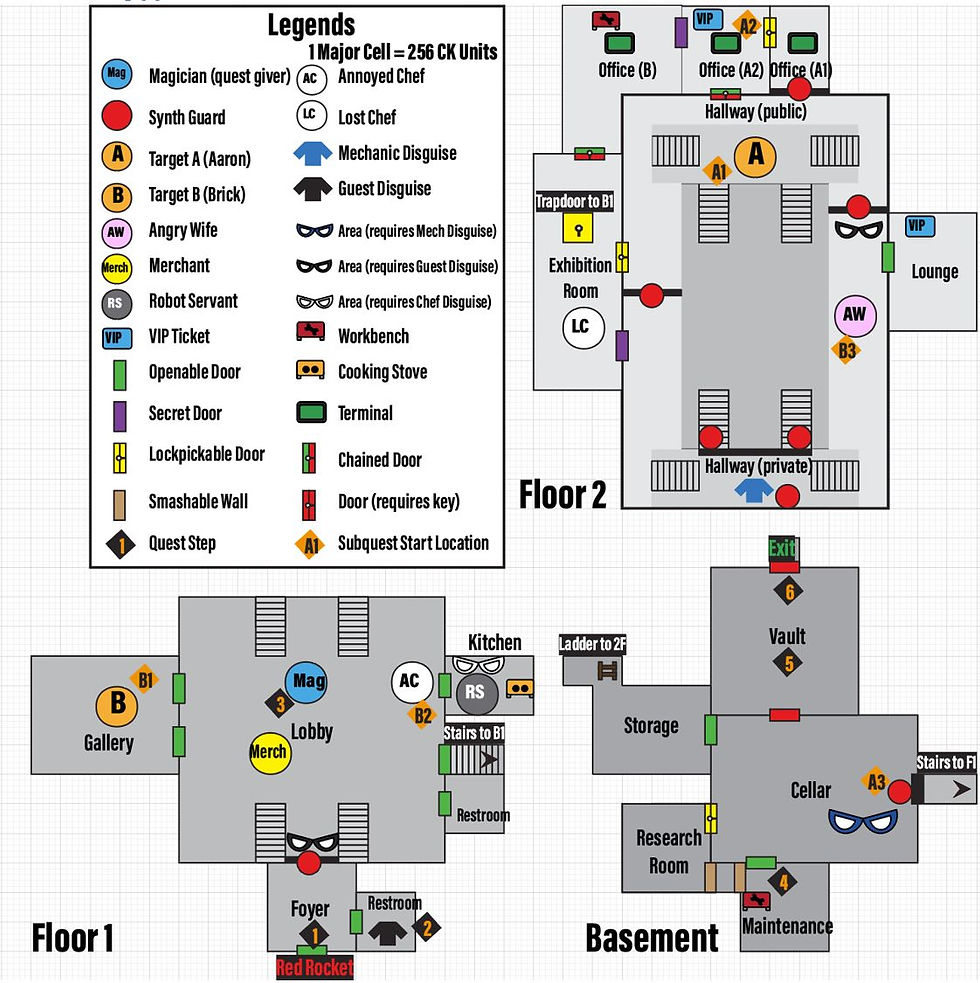
-
“Uninvited Guest” is a single-player level focusing on nonlinear quest design. The goal of the quest is to retrieve the artifact from the vault in the museum during a party
-
To access the vault, the player needs key parts. In various questlines, the player has a wide range of approaches, including improvising, disguising, crafting, and information gathering, to retrieve two key parts from two targets
Gallery




Design Goals
Nonlinear Level Flow
Multiple Flow Options
-
Players should be able to flow through the spaces in many different ways
-
The level follows a hub & spoke design, where the museum lobby acts as the central area connecting different spaces
.png)

-
After entering the lobby for the first time, players can see various points of interest on different sides, and they may explore them in any order they want

-
For the various areas in the level, there are often multiple ways to get there
-
There are often shortcuts in various rooms to create a circular flow and allow a better understand of the space
Dynamic Access to Areas


-
The level layout is designed in conjunction with the disguise system. With different disguises, the player gains access to different areas
-
E.g., putting on a chef disguise allows the player to enter the kitchen
-
-
The player can also gain access to new areas or new path options by acquiring information, which can change the flow
Conveyance for Nonlinear Flow
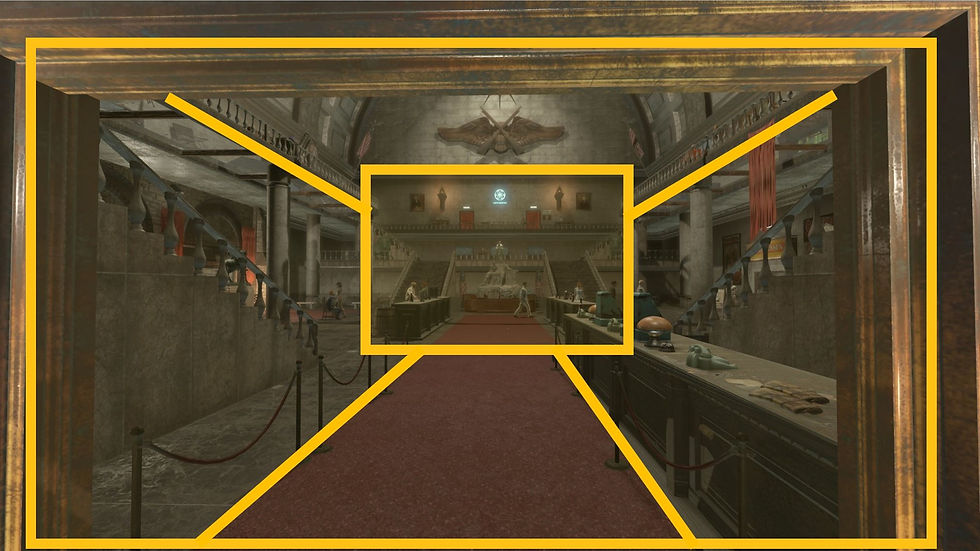
-
The player enters the lobby through the foyer entrance, which pinches and frames the player to look at the center of the lobby. Stairs, carpets, and higher-level floors act as leading lines to the center as well


-
On the wall to the back of the lobby, the giant artworks/symbols act like landmarks that the player could use as navigation aids
-
The props on the two sides have aesthetic differences, suggesting what kind of areas are inside the rooms
-
The key NPCs on two sides are against good color contrast and under good lighting. Most importantly, they are constantly in motion.
-
E.g., At the gallery, Target B (Mr. Brick) is walking around and celebrating his victory in the fist tournament
-




Maintenance Room
Exhibition/Storage Room
Office Room - Target B (Brick)
Vault
-
Each of the museum’s rooms serves different functions and looks different aesthetically
-
The player has a base knowledge of what a museum might look like
-
The museum is taken over by a gang, which impacts how the space looks
-
Some rooms are repurposed to create a different feel
-
Office rooms also showcase the owner's personalities
-
-
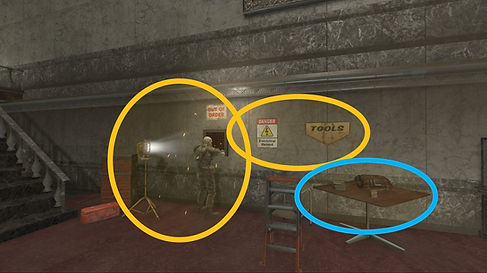

-
Lightings draw player’s attention to different rooms
-
Signs show what is the purpose of the room or where to find a certain location
Player Freedom
Abundance of Options
-
The goal of the main quest is to retrieve two key parts from two different hosts of the party to unlock the vault and retrieve the artifact.
-
Each host has three questlines attached to them, the player can finish any one of the three to get the key part
-
A total of 9 (3 x 3) different combinations of potential playthroughs, which allows the player to express their freedom and increases the replayability
-



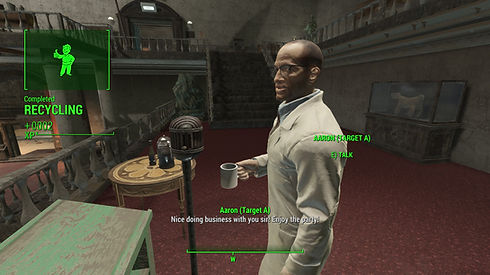




Quest A1 - Purchase through auction
Quest B1 - Win the fist tournament
Quest A2 - Hack servant robot to assassinate
Quest B2 - Craft and serve poisoned food
Quest A3 - Set up an electric trap for an accident
Quest B3 - Identify the secret lover like a detective
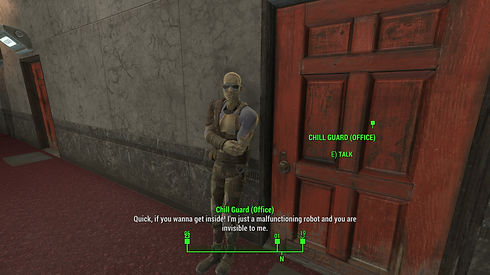
-
Within each questlines, the players are also offered different options on how to complete each of the objectives
-
E.g., To enter the office area, the player can choose to bribe the guard or get a special note from a certain NPC to enter the office
-
-
Different questlines are interactable
-
E.g., The player could sell the engagement ring, a quest item in the lover questline, for plenty of caps, or use it to threaten Target B to win the fight
-
Visibility of Options

-
Various questlines are not shown at the start. Instead, the level encourages the player to go around and talk to different NPCs (guests, quest giver, or the key targets) to identify the opportunities to reveal the questline
Quest Giver Offering Hints
-
The player always has different dialogue options. Certain options allow the player to get extra information on various opportunities
-
There is a custom clue/note system. When the player finds any important messages either from a note, terminal message, or an NPC, it will be automatically recorded into the player’s Pip-boy

Clue/note Triggered Through Dialogue Option
Empowerment with Options

-
With an abundance of options, players should feel that they come up with their own solutions
-
The player should feel empowered as a puppet master, manipulating the NPCs around to orchestrating a show
-
Players could choose to use their brawn to overpower the target or play as a detective to outsmart the target
Exploration Driven
Systems Incentivize Exploration
-
Disguise
-
The player needs to locate the disguises by gathering information and exploring various areas. With the disguise, the player can pass through guards and access off-limit areas to find extra information and items, which creates a positive feedback loop that encourages exploration
-

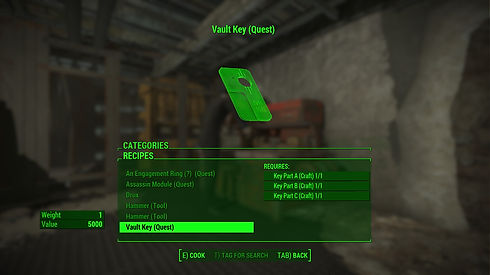
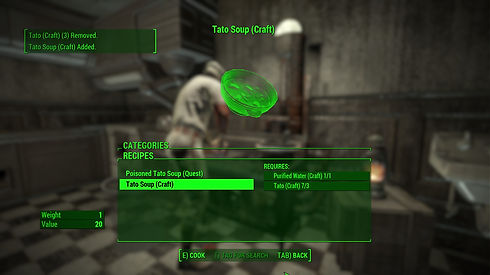
-
Crafting
-
Many of the key quest item in subquests needs to be crafted, and the components are located at different places.
-
The player needs to explore and find them based on various clues. The system acts like an invisible hand to push players to explore
-
E.g., To craft a poisoned soup, the player needs to find raw materials in the kitchen, the rat poison in the basement, and the recipe from the chef. Then the player can craft at the stove after disguising as a chef
-
-
Reward Exploration
-
Players' exploration is always rewarded
-
Besides key item components, there are also valuable items, like paintings, gold bars, and caps, which are sometimes locked up or hidden


-
The player can trade with the merchant in the lobby to sell valuables
-
With extra caps, the player can exchange with the merchant for unique recipes or bribe NPCs
-
-
With gold bars, the player can craft optional but useful items
-
Sometimes, explorations are accompanied by puzzles. Completing the puzzle could itself be an intrinsic reward for the player to feel smart
-
E.g., By observing the calendar in the target’s office, the player could find the safe’s password, which is target B’s secret lover’s birthday
-

Freedom in Exploration

Optional Note for Alternative Solution

-
The quest encourages the player to explore somewhere or try to do something because the player simply wants to do so
-
Ad (Optional Note) on the floor that the player could pick up to reveal an alternative way to complete the fist fight questline
-
-
Rather than providing the exact objective markers, sometimes, the objectives just provide a general sense of direction rather than taking away the player’s fun in exploration
Postmortem
What Went Well
-
Early Planning. The detailed planning in early development eventually led to the quick implementation of Whitebox where I was able to include most of the basic mechanics to grasp a better understanding of how the level will be played out.
-
Creating Interesting Level Layout. Each area in the building has a distinctive look and is rife with interesting things to explore. Various landmarks and points of interest help with the player's navigation.
-
Providing Player Freedom. Besides various questlines, there are plenty of optional areas that the player could explore, and optional items to get or craft. The player also has the freedom to choose the order of exploration.
What Went Wrong
-
Debugging with Nonlinearity. Since the level focuses on nonlinearity, it means that there are a lot of different player options, which creates a problem for playtesting and debugging. To solve the problem, later in the development, I spent a lot of time handling those specific occasions.
-
Providing the Player with Hints. In a nonlinear quest, it is difficult to find the balance of how many hints should be provided to the player. To counter this problem, I added a note system and more information in the form of terminal messages and notes.
-
Creating a Climax. While some combat scene was planned in the original design document at the end of the heist, due to the scope issue, almost all combats were cut from the level. To tackle the problem, I created an interesting puzzle in the vault as the finale.
What I Learned
-
Cut Early. In early development, I soon realized that allowing the player to combat and guards being alerted to the player’s action would be overscoped and does not guarantee fun. So I made the cut early, which makes the final product a better level.
-
Breaking down Systems. I break down my two unique systems in my level in my design document, which not only helps me to understand it better, and implement it faster, but also how I build my level around the mechanics.
-
Creating Fun without Combat or Stealth. While I was trying to emulate games like Hitman and Dishonored, my level features basically no combat and stealth. However, I distilled that the core of both games is a puzzle game featuring a lot of different solutions and relies on information gathering, which becomes the focus of my level.

